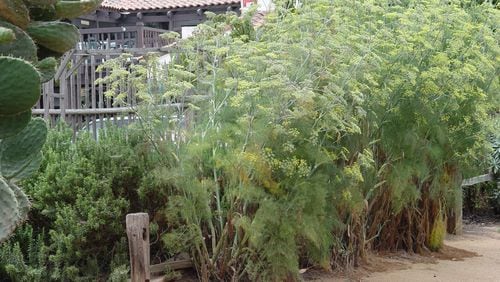It’s said that fennel was old when Troy was new. The big bold Mediterranean herb has its roots in the ancient world, and yet is now as commonplace as any other potentially invasive plant in parts of California. Fennel loves the mild West Coast climate, and where other escapees fail during extended drought, it thrives as it has since long before the pharaohs.
Although fennel is a culinary herb, it is one of the most useful ornamental perennials as well. It is tall and makes a grand statement in drier gardens because this is an umbelliferous plant. That means it bears flowers in starburst structures called umbels that are open and airy and transparent. After blooms fade, seed pods form and the umbels become exceptional dried flowers to cut and bring indoors.
The umbels rise up above so many other plants, the yellow flowers catching the light to literally glow in the soft illumination of morning and evening. Umbels also have a duel nature, for they are equally as interesting front-lighted against walls for casting the most delightful shadows when in flower.
When you observe the foliage, it’s soft and fluffy, the exact opposite of the crisp clear flower structures. Fennel is available with two foliage colors: standard bright green and dark purple. Put the purple in places you need color contrast with too many bright green plants. These almost smoky-looking clouds are soft and easy to use as background for high contrast plants, succulents and art.
Fennel is also a staple of the Mediterranean garden, thriving on the same conditions as sage and rosemary. It is also exceptional in Italian terra cotta pots in small courtyards and patios. Mound your soil in wetter climates to keep the crowns of these plants slightly elevated to help them at the cool end of their climatic tolerance.
But these are merely her physical traits. To the foodie, the plant is herb-flavored, strongly reminiscent of anise. A bulbing fennel variety looks the same as the herb but develops a celerylike base, also anise-flavored. It’s traditional to saute sliced bulbs for hot meals or marinate them in olive oil for zest in cold summer salads. Foliage of course is requisite in many salads, dips and dishes as well. The best way to prepare is by snipping them with scissors to just the right size.
Fennel is so easily adapted it even thrives in desert heat. When shopping for seedlings, note the label, because all fennels are not bulbing. This is also true for seed. Avoid unlabeled plants if you’re not sure, or you may end up with a huge plant that only gives you its leaves to eat.
Give fennel great sun and well drained ground. It prefers drier conditions and will tolerate heavier soils where moisture doesn’t linger. Fennel is such an easy plant it self-sows prodigiously where there is sufficient moisture to support them. Problems with invasive fennel in wild lands are usually related to wetlands or waterways because the long summer drought in the West is not enough for naturalization. Gardeners can easily harvest save their seed for future crops. Both standard green and purple fennel are available at garden centers nationwide as seedlings in quart and gallon sizes.
To really make fennel look great, combine it with other Mediterranean ornamental plants and arid Western natives. It shares the same conditions as grey leaf Artemisia species, orchid rockrose, Cistus purpureus, Southwestern natives like autumn sage, Salvia greggii. Spanish lavender loves the same well drained conditions and full sun exposure.
Of all the garden herbs, none is as big and bold as fennel. It has many roles in medicine and flavors of old world cooking. Where the climate limits what we can grow with moderate water supplies, fennel is queen of the border. She stands regally today, just as she did in A.D. 812, when Charlemagne ordered fennel grown in all the imperial farms as Rome spread cultivation throughout the Western world.
———
Maureen Gilmer is an author, horticulturist and landscape designer. Learn more at www.MoPlants.com
About the Author






